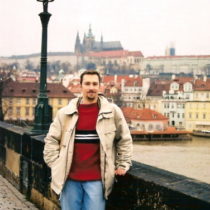Landscape Architecture for Landscape Architects › Forums › GENERAL DISCUSSION › Thomas Kinkade (RIP) Landscape Painter
- This topic has 1 reply, 9 voices, and was last updated 13 years, 8 months ago by
 nca.
nca.
-
AuthorPosts
-
April 7, 2012 at 7:28 am #157989
 Edward FlahertyParticipant
Edward FlahertyParticipantThomas Kinkade, landscape painter, has passed away. Looking at his work I wonder, just exactly where the vision of a painter and the practice of landscape architecture share some ground? Comments?
 April 7, 2012 at 7:36 am #158005
April 7, 2012 at 7:36 am #158005 ncaParticipant
ncaParticipantI’ve admired his work for a few years now. We had a gallery of his work not far from where we lived in Denver. Too young..
April 7, 2012 at 11:14 am #158004 Leslie B WagleParticipant
Leslie B WagleParticipantI like his work for technique and even read one of his books….but one tiny thing I always notice is that in his clearly “spring” scenes of cabins surrounded by blooming dogwoods, there is often smoke coming from the chimneys, and he shows street lights burning when it is not really dark. They have chilly springs in his worlds, I guess. Our dogwoods are halfway out right now in N.C. and the wood stove had to get churning last night.
The thatched cabin village scenes were his popular side, but I’ve seen a few seascapes-only that were simply amazing,
April 7, 2012 at 12:30 pm #158003 Edward FlahertyParticipant
Edward FlahertyParticipantInteresting, the language used to describe his painting…it is about moods…sentimental…I wonder why I rarely see landscape architecture built projects or even non-built projects described by emotional descriptives.
Do we build without emotion? Or, do we not know how to design with build in emotion? Or, does emotion only come in the eye of the beholder?
Raw landscapes have emotive power…examples?
What about our stock built landscapes and gardens?
April 7, 2012 at 5:16 pm #158002 Roland BeinertParticipant
Roland BeinertParticipantI think Olmsted and earlier people like Capability Brown designed with emotion and sentiment in mind. I think they were partially inspired earlier landscape painters.
April 7, 2012 at 6:27 pm #158001 Bob LutherParticipant
Bob LutherParticipantWhen you deal in fantasy and without a budget and have the perfect setting anything is possible… It is also one perfect vantage point of an idealic scene, in the design landscape we often don’t ask the viewer to stand in one exact spot to create the visual, we ask the view to move through the space, or use the space, or be apart of the space not just an outsider looking in.
April 7, 2012 at 7:22 pm #158000 Jason T. RadiceParticipant
Jason T. RadiceParticipantLet alone rip-offs. People bought prints for high hundreds to thousands of dollars expecting them to be worth something someday, but ended up with the Hummel figures or NASCAR plates of the art world. Not saying his paintings were terrible, if that is your taste, but he sold hundreds of “hand touched prints” for exorbitant amounts of money. And the prints were not “hand touched” by him, but rather a paintng mill of assembly line workers with white paint.They aren’t worth more than the canvas they are printed on. Painter of light? No. Rembrandt was THE painter of light. Period.
Still, terrible the guy died so young. He was a marketing genius.
April 7, 2012 at 10:03 pm #157999 ncaParticipant
ncaParticipantAll the critique aside, some of which I think is valid, you’ve got to give the man credit for a) being a marketing genius and b) bringing art to people who typically think they dont care about art….oh yeah and c) making cool paintings.
April 7, 2012 at 10:12 pm #157998 Bob LutherParticipant
Bob LutherParticipantAbsolutely!
April 8, 2012 at 1:38 am #157997 Leslie B WagleParticipant
Leslie B WagleParticipantI was reading some of the less flattering comments on another site earlier, and one of the funnier ones said his approach was something like “people like bridges, so I’ll use bridges; people like lights in windows so I’ll make the cottages look like they’re on fire; people like chimneys, so I’ll put in 2-5 per cottage.” But the writer said you have to admit, he never went so far as to put chimneys and lit up windows on his bridges.
April 8, 2012 at 1:55 am #157996 ncaParticipant
ncaParticipantThe art and architecture world are not that unlike.
We cry about being poor, starving geniuses, then stick our noses up at anyone actually delivering a marketable product because they found a formula to appeal to the ‘masses.’
This economy is going to change that.
April 8, 2012 at 6:53 pm #157995Anonymous
InactiveShame on both of you… for saying exactly what I was thinking. That style of painting just makes me feel uncomfortable and I don’t know why.
But I’ll try to be open minded about the definition of “good” art. If he was able to make a living creating art that people enjoy, he was a winner in my book.
Anyway, rest in peace dude.
April 8, 2012 at 7:09 pm #157994 Andrew Garulay, RLAParticipant
Andrew Garulay, RLAParticipantHe gave some people something they liked. That is a good thing. I don’t like it, but it is a great thing that he brought joy to those that did. It does not mean that every painter should paint this way.
It is the same with real landscapes. Enjoy the parts of the diversity that you like and get over the things that you don’t like, but be glad you have the choice either as a producer or admirer.
April 8, 2012 at 7:55 pm #157993 Edward FlahertyParticipant
Edward FlahertyParticipantI really was looking at the idea of emotional content in designed and built landscapes and gardens. Kinkade’s work draws emotional responses…perhaps he aimed to achieve an emotional content in his work.
For me the issue was not whether his work was good or not. Rather how does a landscape architect design and build to get emotional involvement by the users? That is an interesting topic…comments?
April 8, 2012 at 10:05 pm #157992 BoilerplaterParticipant
BoilerplaterParticipantYeah, its “Mall Art”. Its kitsch. But I think understanding the appeal of this kind of art is worth studying. Does the viewer like to imagine themselves in such a landscape? In a little cottage with a thatched roof? He did observe rules of composition that work for designed landscapes as well. A lot of New Urbanism work gets the same kind of criticism, that it is overly cute and nostalgic and not really workable for current development practices. Maybe those cute little house on small lots (property lines never seem to be obvious in his paintings, another deceit?) really ARE conducive to sociability. And those thatched roofs, they come from locally sourced marsh reeds. LEED points right there! The houses have small windows and thick walls to minimize heat loss. Note that there is typically little to no lawn to water, fertilize and mow, just billowy masses of flowering plants. Lawns are biological deserts and create polluted runoff, right? Can’t have that. All those chimneys remind you that they produce their own energy with a renewable source. Maybe they are also there to remind the viewer of the draw of fire for humans, the way people have gathered around campfires for eons, the way they reunite people and are made to mark important occasions. It stirs up pleasant memories.
My mom has a copy of a novel he co-wrote. From the dust jacket: “Thomas Kinkade is America’s most collected artist, a painter commuicator whose tranquil, light-infused paintings bring hope and joy to millions each year.” There you have it – hope and joy. If a developer were to take one of his little village scenes, or even just on cottage, and replicate it as authentically as possible, I’m sure they would sell rapidly and for a premium over other houses of comparable size. I’ll take one over a Toll Brothers McMansion any day.
-
AuthorPosts
- You must be logged in to reply to this topic.


